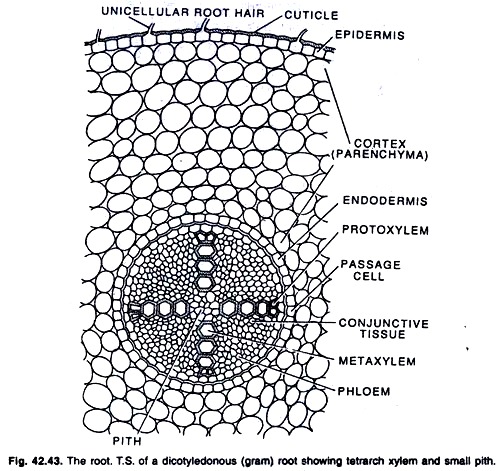Let us learn about Secondary Growth in Dicotyledonous Roots. After reading this article you will learn about: 1. Introduction to Secondary Growth 2. Formation of Cambium and Development of Secondary Tissues 3. Periderm.
Introduction to Secondary Growth:
The roots of gymnosperms and most dicotyledonous undergo secondary growth. Most of the dicotyledonous roots show secondary growth in thickness, similar to that of dicotyledonous stems. However, the roots of extant vascular cryptogams and most monocotyledons do not show any secondary growth; they remain entirely primary throughout their life.
The secondary tissues developed in the dicotyledonous roots are fundamentally quite similar to that of dicotyledonous stems, but the process initiates in some different manner. Certain dicotyledonous roots do not show secondary growth. The secondary vascular tissues originate as a result of the cambial activity. The phellogen gives rise to the periderm.
Formation of Cambium and Development of Secondary Tissues:
The dicotyledonous roots posses a limited number of radial vascular bundles with exarch xylem. Normally the pith is very little or altogether absent. On the initiation of secondary growth, a few parenchyma cells beneath each group of phloem become meristematic and thus as many cambial strips are formed as the number of phloem groups.
The cambial cells divide tangentially again and again and produce secondary tissues. Thereafter some of the cells of single layered pericycle become meristematic lying against the protoxylem groups, which divide and form a few layers of cells. The first formed cambium now extends towards both of its edges and reaches the inner most derivatives of the pericycle, thus giving rise to a complete ring of cambium.
The cambium ring is wavy in outline, as it passes internal to phloem and external to xylem groups. The cambial cells produce more xylem elements than phloem. The first formed cambium produces secondary xylem much earlier, and the wavy cambium ring ultimately becomes circular.
Now whole of the cambium ring becomes actively meristematic, and behaves in the similar way as in the stem, giving rise to secondary xylem on its inner side and secondary phloem towards outside.
The secondary vascular tissues form a continuous cylinder and usually the primary xylem gets embedded in it. At this stage distinction can be made only by exarch primary xylem located in the centre. The primary phloem elements are generally seen in crushed condition.
The cambial cells that originate from the pericycle lying against the groups of protoxylem function as ray initials and produce broad vascular rays. These rays are traversed in the xylem and phloem through cambium; this is characteristic feature of the roots. Normally, such rays are called medullary rays.
Periderm:
Simultaneously the periderm develops in the outer region of the root. The single layered pericycle becomes meristematic and divides, giving rise to cork cambium or phellogen. It produces a few brownish layers of cork cells or phellem towards outside, and the pheliodorm on the inside.
The phelloderm does not contain chloroplasts. The pressure caused by secondary tissues ruptures the cortex with endodermis, which is ultimately sloughed off. The epiblema dies out earlier. Lenticels may also be formed.







